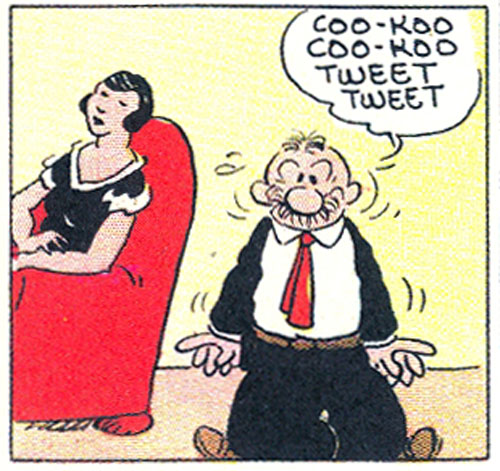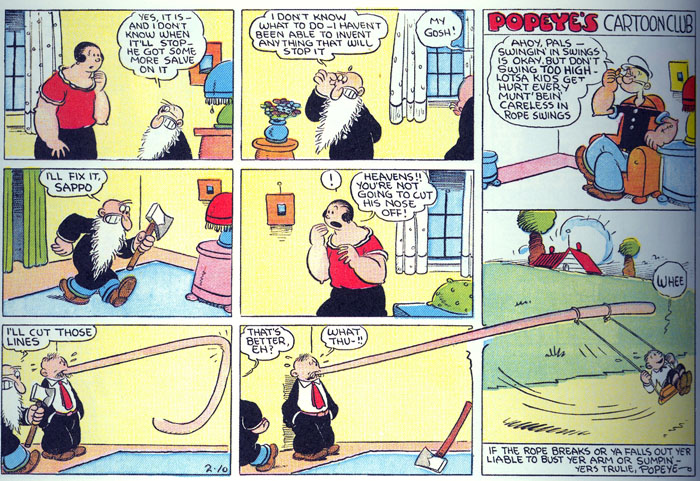For me, E.C. Segar’s Popeye remains, no matter what Noah says, not only one of the great comics of the 20th century but a great piece of Americana as well. It manages to combine hilarious slapstick, daffy absurdity, high adventure, sentimental melodrama and still create genuine emotion and care for the cast’s well-being. It deserves every ounce of acclaim and high regard it’s earned over the years.
But I’m not going to be talking about any of that today. Instead I’m going to be talking about Popeye’s less benighted comic strip brother, Sappo.
Sappo was E.C. Segar’s topper to the Sunday Popeye strips. Many popular strips had a second gag strip that ran along the bottom or top of their Sundays back in in the 1920s and 30s. The idea being that the syndicates and papers could claim they ran more strips without having to add pages to their Sunday section. Gasoline Alley, for example, had That Phoney Nickel, about the travails of a, well, you figure it out. Barney Google had the bizarre soap opera parody Parlor Bedroom & Sink. Little Orphan Annie had the irascible Maw Green, who once declared that the only problem with Russian Roulette is that not enough Russians play it.
And Popeye had Sappo. The strip began, according to Wikipedia, as The Five Fifteen in 1921, and was the sort of typical squabbling man and wife strips that Jiggs and Maggie (of Bringing Up Father fame) had made so popular. It starred the squat, mustachioed Sappo, his rather tall, pleasingly plump wife Myrtle, a host of eccentric boarders, and engaged in the type of sexual politics that were common at the time. In other words, a lot of dishes and rolling pins were thrown Sappo’s way and comments were frequently made about how much women liked to spend on hats (you can see some early Sappo strips in the second of Fantagraphics’ Popeye volumes).
The strip was rechristened Sappo in 1926 (Segar apparently realizing The Five Fifteen is a horrible name for a strip), and it eventually moved to the top tier of Sunday’s Thimble Theater, where it stayed. Apparently Segar was too in love with his short-tall matrimonial pair to let them fall by the wayside. And it was a good thing that he did so, for it wasn’t until Sappo and Myrtle took up residence above the Theater that something magical began to happen.
Eventually, as Segar discovered Popeye and his cartooning and storytelling abilities deepened, Sappo began to evolve beyond the boundaries of its simple “marriage is hell” conceit. Freed from being Segar’s star character, and thus, any expectation or hope of having any importance, be it cultural or financial, Segar threw caution to the wind and let Sappo travel to strange odd places, like, for example, Mars.
As manic and silly as Thimble Theater could be, Segar had to keep his characters grounded within a somewhat realistic world. While Popeye could survive countless gunshot wounds and characters would physically “plop” out of the panel upon hearing a punchline, there had to be at least be some possibility of an actual threat, if not death, for readers to care about what happened next. If you were expected to care whether Olive gave Popeye the gate or not, or wonder whether he was going to win the next prize fight or would lose Swee Pea to his real mom, then Segar had to place his characters in a world that at least resembled our own, however sketchily.
Sappo though — who the hell cared what happened to him? No one was lining up at the cinema to catch the latest Sappo cartoon. Thus, the level of absurdity grew in intensity to fever-pitch levels. The couple’s boarders started to become stranger by the minute. Sappo decided to imagine himself as a great inventor and started developing kooky inventions like hair-cutting machines and walnut hullers.
The strip didn’t really become inspired, however, until the couple took in the fabulous bearded inventor O.G. Wottasnozzle. As Donald Phelps says in his introduction to the second volume, “When Wottasnozzle cackled his way into their family circle, the Sappos were delivered over to a fantasy more giddy-spirited, more loosely playful, than any of the impersonations or sorceries under Popeye’s reign.”
How true. With Wottasnozzle creating an endless array of ridiculous gadgets (and causing no small amount of chaos in the process) Sappo found himself thrown into the solar system, shrunk down to microscopic size (where he had to fight evil viruses), deal with mechanical men that made eyes at his wife, and got involved with a ridiculous battle of the scientists between Wotasnozzle and the nefarious Finklesnop that ended with the former literally enlarging his brain (decades before Barry Allen attempted it I might add) in order to think up an ultimate weapon.
As the strip developed, the playfulness got even more loose and inspired, at times even breaking down the fourth wall, as in an episode where, because of Wottasnozzle’s growth forumla, Sappo’s nose breaks through the panels into the “educational” cartoon that ran next to it, where it was used as a child’s swing.
Sadly, like all good things, it did not last. Having either grown bored with Sappo, Myrtle and Wottasnozzle, or wanting to devote more time to Popeye, or simply running out of wacky ideas, the strip started to take up less space and became a “how to draw” guide where Sappo would show young readers at home how to turn the number 6 into a person’s nose and so forth. Eventually it faded away completely and toppers themselves went the way of the Zoot Suit. But for a brief time a very short man went to Mars, shrunk to the size of a virus, became invisible, had a nose that grew several miles long and got punched in the mouth by a very big fish. And it all was glorious.
____________
Update by Noah: The entire Popeye roundtable is here.








It’s a crying shame that Sappo never enjoyed remotely the success or notoriety of Popeye. “Jerk with deranged scientist pal” is a concept that writes itself.
Chris, is that Myrtle in the red chair in the first panel?
Didn’t Segar (or whoever took over Popeye after him) eventually bring O.G. Wottasnozzle into the Popeye strip?
Caro — Yes, though it’s a 16-year-old version of Myrtle, as she regressed in age thanks to one of Wottasnozzle’s inventions in that particular strip. The “real” Myrtle is more heavy-set and usually has her angry face on.
Richard — I don’t recall any of the Segar strips having Wottasnozzle, but that doesn’t mean you’re wrong. It seems more likely that one of his successors brought him in though.
I think Grant Morrison has used that brain expansion trick….
Maybe I’ll go back and just read the Sappo and skip the Popeye!